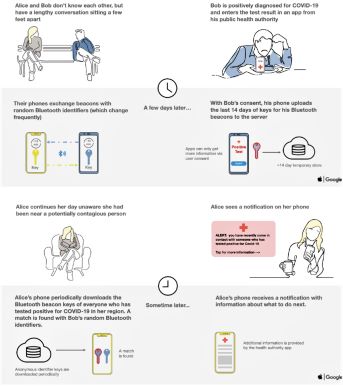A program to test a smartphone-based COVID-19 exposure notification system will expand to an additional five University of California campus locations as a result of accomplishments from an initial deployment earlier this fall at two UC campuses. The program is a joint effort between the University and the State of California to assess use of the technology on a voluntary basis as a means of reducing the spread of the virus.
The effort uses Google/Apple Exposure Notification (GAEN) technology on smartphones to supplement the essential work of human contact tracers and help further reduce the spread of SARS-CoV-2, the virus that causes COVID-19. A major goal of this pilot is to determine if using this smartphone technology can encourage users to respond to a high-risk exposure more quickly by self-isolating and receiving additional clinical resources, which are key to limiting the spread of COVID-19.
“What started six weeks ago with two UC campuses has now grown to the majority of UC campuses,” says Dr. Carrie L. Byington, executive vice president of University of California Health and an infectious disease expert. “Applying this type of innovation to a practical use is part of our mission to improve the health of the people of California. This demonstrates the commitment across the University to battling COVID-19 in collaboration with the state of California. We are in this fight together.”
The program allows those who volunteer to use the technology to receive automatic smartphone notifications of a potential exposure to other enrolled users diagnosed with COVID-19, regardless of whether the users know each other.
As part of the privacy-first approach, users decide whether they want to share a verified positive test result with the app and determine whether they want to share that with other users. State and university epidemiologists are reviewing the results of the pilot to determine how to optimize the smartphone-based technology and whether it should be rolled out more broadly.
“We are pleased that the initial launch of the program was well received by students and employees at our first two participating campuses,” said Dr. Christopher Longhurst, chief information officer, UC San Diego Health, which is leading the UC program in partnership with the State. “California is a state known for its innovation and that forward thinking applies to health as well. With even more people now eligible to use the exposure notification system, we will be able to see how we can use it as a powerful tool to slow the spread of the virus.”
UC San Diego and UC San Francisco, along with their respective health campuses, began the pilot earlier this fall, and California public health authorities authorized an expansion to additional UC locations. As a result, the pilot will be expanded to a more demographically diverse set of students, faculty and staff, and will provide additional scale for evaluating clinical success.
The locations joining the program are: UC Berkeley, UC Davis, UCLA, UC Riverside and UC Santa Barbara covering people across northern, southern and central valley areas of California. Additional UC locations may join the pilot in coming weeks. Although the software does not allow tracking of users, UC’s investigators for the study estimate that more than 20,000 users at the initial two campus locations have activated the software.
“Extending the pilot project allows us to reach a larger and more diverse pool of users to further evaluate the technology’s potential to help California slow the spread of COVID-19,” said Dr. Erica Pan, Interim State Public Health Officer. “Fighting COVID-19 will continue to take all of us working together to find innovative and creative ways to keep our communities safe and healthy. Our appreciation goes out to the University of California students and employees who have opted in to test this new technology.”
About the technology
The Google/Apple technology employs Bluetooth to communicate with other Bluetooth-enabled devices nearby, such as the smartphones of people who at the same time are traveling on a plane, standing with in line at a grocery store or sharing space inside a classroom or dormitory. When a person opts into using the Google/Apple notification system, the user’s phone broadcasts a random identification (ID) number to other phones in the area. When phones come within 6 feet of each another, they log each other’s IDs — without names or locations attached.

Credit: Google/Apple Exposure Notification FAQ, p. 4, https://covid19-static.cdn-apple.com/applications/covid19/current/stati…
If a person is diagnosed with COVID-19, they can voluntarily enter a keycode indicating they received a positive test result. This approach will generate an anonymous alert to other users based on proximity and length of exposure.
To learn more about GAEN, visit the information pages from Google and Apple.
About University of California Health
University of California Health (UCH) comprises six academic health centers, 20 health professional schools, a Global Health Institute and systemwide services that improve the health of patients and the University’s students, faculty and employees. All of UC’s hospitals are ranked among the best in California and its medical schools and health professional schools are nationally ranked in their respective areas. More information and news from University of California Health is available here.